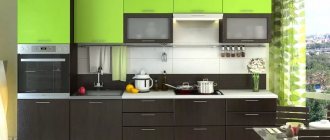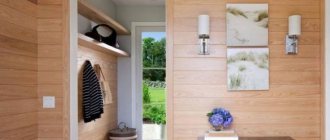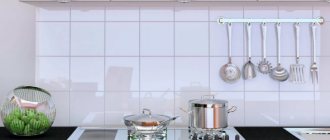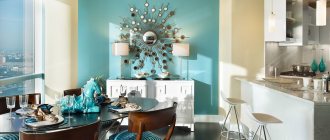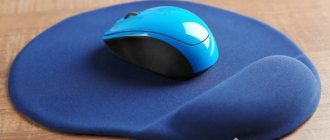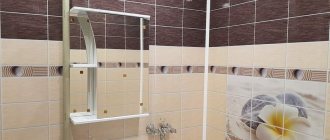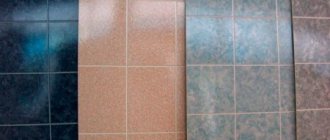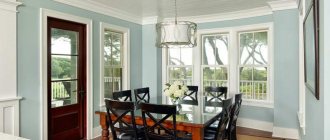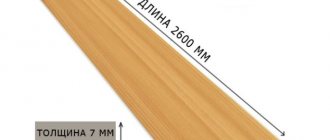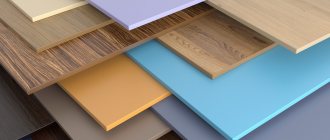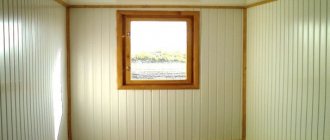MDF panels are a building material intended for finishing premises, cladding the facades of cabinet furniture or walls; it is made from wood chips of low or medium thickness. These parts are considered an environmentally friendly finishing element, since synthetic adhesives are not used in their production, but natural wood resin is used, which reliably fixes all layers of the product and forms a single whole. MDF panels have medium and low density, depending on the number of layers and composition of the wood. Over time, during the operation of these parts, their surface may become scratched, the coating loses its gloss or has defects, as a result, the integrity of the entire panel is compromised, and the appearance of the entire finish becomes unsightly. Any owner in this case is faced with the question: how to update the facade of the panels without completely changing them?
MDF panels on the wall
This article discusses the possibility of painting products such as MDF wall panels, whether it is possible to paint MDF, as well as the process of carrying out such work at home.
Why do this?
Many people wonder: is it possible to paint MDF at home, and why is this necessary? The answer to the first part of the question is yes. Indeed, you can paint the panels yourself. But it’s worth making a reservation right away: if you don’t have a spray booth at hand, the result is not always ideal. The coloring procedure is necessary for the following reasons:
- Painted elements become more resistant to high temperatures and humidity. Therefore, they can be used in the kitchen and bathroom, where they can fulfill different roles.
- By decorating, it is possible to diversify a dull interior and refresh the appearance of the room. The shade is chosen based on the design ideas.
- Painting MDF panels is also necessary in order to extend their service life.
Painting MDF allows you not only to diversify a boring interior, but also to extend the life of the product.
Of course, this option also has some disadvantages. For example, this procedure is sometimes much more expensive than using decorative films. In addition, the surface becomes prone to fading.
Types of varnishes
Instead of painting, you can choose varnish. To reliably varnish MDF, you need to apply several layers and wait until it dries completely each time. The process will take a long time and require effort.
If you still decide to choose a varnish, then pay attention not only to its cost and composition, but also to wear resistance, resistance to humidity, and high temperature. To coat MDF boards at home, you can use several different types of varnishes.
The cheapest compositions in this segment are alcohol-based and have a short drying time (up to half an hour), that is, they are quick-drying. Traditional inexpensive varnishes include oil-based varnishes, which not only give a beautiful appearance to surfaces, but also effectively protect them from moisture.
Note! For coating MDF countertops, an excellent choice would be two-component epoxy varnishes, which are characterized by increased resistance to impact.
Acrylic varnishes are good because they are odorless, do not emit toxic substances, and are not washed off or diluted with water. Another popular option is polyurethane varnish. It is characterized by enviable wear resistance and good adhesion to wood-based materials.
As for those cases where further polishing of MDF products is expected, nitrocellulose varnishes are the best option.
Selection of materials for painting
In principle, all paints for MDF are selected taking into account the composition of the material. And this is, first of all, a fine wood fraction, which means that paint solutions for wood are suitable for the job. But to obtain a truly high-quality coating, it is advisable to use special mixtures.
Polyurethane enamels
This material should be preferred for the following reasons:
- The coating is wear-resistant and can withstand exposure to household chemicals.
- The solution does not have an unpleasant odor, which makes it possible to carry out work in cramped home conditions.
- The mixture can be applied using a sprayer, roller and brush.
- Painting MDF with enamel is done independently; this procedure does not require professional skills.
Naturally, when choosing this material, they pay attention to the manufacturer. It should be a well-known brand that is sold in specialized stores. When purchasing a product from an unknown manufacturer, there is a high probability of getting a fake.
Advice! If it is not possible to select a polyurethane composition, then pay attention to alkyd enamels and paints (oil and acrylic).
When choosing paint, you need to pay attention to the manufacturer
Thus, the question of how to paint MDF panels is no longer a problem. But another dilemma arises - the surface needs additional protection, how can this be done?
Indeed, to increase resistance to mechanical stress and protect against chemical compounds, varnish is used. And for such work, a two-component polyurethane composition is especially suitable, which has all the desired parameters.
Stages and technology of painting
The procedure for painting MDF with your own hands is carried out in several stages. They can be divided as follows:
- Grinding.
- Putty.
- Padding.
- Coloring.
- Varnishing (patination).
Completing each stage is a guarantee that the result will turn out as intended.
Work begins with grinding the surface. This is a rather labor-intensive task that must be performed carefully.
The panels are sanded with sandpaper with grit from 120 to 240 units. The process is performed in several stages and using different materials. Everything must be done very carefully, without staying long in one area. This procedure is carried out in order to remove small irregularities, as well as remove the fine lint that covers the entire surface.
The MDF sanding procedure allows you to get rid of small irregularities on the surface of the board
On a note! If there are milled areas on the front side, it is better not to touch them. There is a good chance that the sandpaper will smooth out the corners of the design.
Puttying
Puttying MDF for painting has the goal of correcting the existing shortcomings of the panel. It happens that during grinding or due to improper storage, cracks or dents appear on the surface. To hide them, putty is used. Of course, if there are no such problems, then this stage is skipped.
The technology itself looks like this: the acrylic mixture is carefully applied to the desired area and leveled with a rubber spatula. After drying, be sure to sand it.
Padding
This stage is mandatory. It is conventionally divided into two processes:
- Applying the first layer of primer This is done using a spray gun, so the room and place for work are prepared. It is better to cover other items with cellophane film in advance.
- The mixture is sprayed over the entire surface of the panel in an even layer. This is done in order to raise the remaining pile and reduce the absorption of the base materials.
- Next, when the slab is dry, it is sanded using fine sandpaper.
- The second layer is applied in order to consolidate the result and remove remaining blemishes.
Coloring
Can MDF be painted with a brush and roller? Yes, but this should be done very carefully. There is a high probability that stains and streaks will remain on the surface. Therefore, it is best to use a spray gun.
The technology itself resembles priming. The paint is applied in several layers, each of which is pre-dried. It is important to achieve an excellent result, so the mixture begins to be sprayed from the milled areas to the edges, and then passes along and diagonally. It is much more convenient to paint smooth panels.
To paint MDF you can use brushes and a roller, but to obtain an even layer it is better to use a spray gun
On a note! To understand in more detail the drying time of the solution and its quantity, you must carefully study the manufacturer’s instructions. And also select the desired operating mode for the sprayer.
Necessary tools for varnishing
The material sets quickly, so you need to prepare everything you need to work with it:
Small tool for varnishing MDF.
- container for creating the mixture (if a two-component composition is used);
- a construction mixer or a special attachment for an electric drill;
- spray bottle, brushes of different sizes (narrow and medium width), roller;
- devices for making ornaments: sponge, construction tape, stencil;
- solvent, when you need to dilute the varnish to obtain the required consistency;
- sandpaper of different grits for sanding the surface.
When choosing, the configuration of the structure being processed is also taken into account; if there are difficult areas, prepare a small brush. It is also used when the main tool is a spray gun or roller. A narrow brush will help to treat hard-to-reach areas and small details.
During work, use protective equipment: rubber gloves, a respirator. When MDF board is treated with varnish containing a high percentage of volatile toxic components, the respiratory tract is protected. Otherwise, the risk of poisoning by toluene and xylene vapors increases.
If you want antique
If there is a desire to give the surface a more expressive look, to age it a little, then they resort to patination. It is advisable to do this when there are drawings and patterns.
Patina is applied in this way:
- walk over the selected area with a sponge soaked in the mixture;
- leave until completely dry;
- the painted area is sanded;
- proceed to the final stage.
You can create the effect of artificial aging yourself by resorting to patination of the surface.
The procedure is carried out according to the instructions:
- The varnish is prepared for use.
- The first layer is applied at the rate of about 150 grams per square meter.
- After waiting for the first layer to dry well, apply a new layer.
- Repeat the drying process.
- Final sanding begins. First, sandpaper with a coarse grain is passed over the surface, then a finer one is used. To avoid lumps forming, spray the area with water.
- The panel is left for several days (from 4 to 7) and polished. For this it is better to use a power tool.
There are many tips on how to properly paint MDF. The main thing is to follow a clear plan and be careful.
How to paint MDF panels
MDF panels are a building material intended for finishing premises, cladding the facades of cabinet furniture or walls; it is made from wood chips of low or medium thickness. These parts are considered an environmentally friendly finishing element, since synthetic adhesives are not used in their production, but natural wood resin is used, which reliably fixes all layers of the product and forms a single whole. MDF panels have medium and low density, depending on the number of layers and composition of the wood. Over time, during the operation of these parts, their surface may become scratched, the coating loses its gloss or has defects, as a result, the integrity of the entire panel is compromised, and the appearance of the entire finish becomes unsightly. Any owner in this case is faced with the question: how to update the facade of the panels without completely changing them?
MDF panels on the wall
This article discusses the possibility of painting products such as MDF wall panels, whether it is possible to paint MDF, as well as the process of carrying out such work at home.
What to combine with a glossy set?
Whatever you say, a glossy set, regardless of color, will stand out and attract attention.
Glossy MDF painting is undoubtedly an accent in the interior. It is better to surround it with discreet matte surfaces. This applies to the tabletop - it will also be more convenient, but it is especially important for the ceiling and floors.
A glossy set in combination with a glossy ceiling will not look as impressive as gloss on a matte background. The combined facades look interesting - the top is glossy and the bottom is matte. Or, for example, all horizontal surfaces are dark matte, and vertical surfaces are bright gloss.
The combination of a glossy finish with natural materials or their imitation looks interesting. Wooden details or a stone countertop will contrast very favorably with the brightness of the gloss.
Gloss MDF painting is a suitable choice for any modern design. It doesn’t matter whether it’s high-tech, loft, modern or fusion. By choosing the right color you can easily fit such furniture into the interior.
Reasons for the formation of defects
There are a number of reasons why painting MDF panels may be necessary, including:
- Mechanical damage to the surface as a result of impact with a sharp object or other material. The top layer of the MDF panel consists of laminated or plain paper with paint applied to it; when exposed to a hard object, the film breaks, which exposes the core of the entire product;
- Paint fading, loss of color brightness. This deformation is caused by exposure to ultraviolet rays and atmospheric air, which contains a small amount of moisture. Over time, the coating becomes matte, loses its shine and original appearance;
- Temperature changes also negatively affect the external condition of the surface of MDF panels, since the internal structure consists of wood, which absorbs moisture from the atmosphere and at the same time swells over the entire area. When the temperature rises, MDF dries out and may crack; moreover, the glue contained in the panel loses its ability due to moisture, which leads to peeling of paper, lamination and shavings.
These causes of deformation lead to an unsightly appearance of the entire surface and disrupt the overall design of the wall. If these defects occur, you can paint MDF panels after first completing a number of preparatory procedures, but you should understand that painting parts with your own hands at home brings a result that differs from processing with paints in production.
Painting process for MDF panels
Before answering the question of how to paint MDF panels, you need to understand the composition of this product. An MDF board, wall or facade, consists of several layers of compressed paper and sawdust, laminated with a transparent or colored film on the front side. Most often, it is the top layer that is subject to damage and wear, so when planning to update MDF, you need to prepare the specified types of coatings.
In order to prepare MDF panels for painting at home, you will need:
- Sandpaper for preparing the surface and removing gloss or varnish;
- Solvent for degreasing the surface from glue and liquid residues;
- Dry rags or other lint-free cloth.
These materials are necessary for pre-treatment of MDF panels for painting and sealing cracks and scratches on the laminate.
Priming MDF panels
All work must be carried out in accordance with the action algorithm. The first step is to sand the panel with fine sandpaper; this can be done manually or using a pneumatic tool. It is important to follow the varnish removal technology, to prevent overheating of the surface or the formation of large marks on the laminate. The wood-fiber surface is under the decorative film, so when sanding you need to carefully monitor the thickness of the top layer so as not to erase it completely. After this procedure, the coating will no longer shine and will become rough and slightly scratchy.
Next, you need to clean all cracks and chips from dirt and dust, and also clean their edges. All irregularities, if necessary, are smoothed over with a special putty, which forms a single whole with the base of the panel; it also needs to be leveled with sandpaper.
After the surface has been processed and leveled, it must be wiped with a dry cloth and degreased with a chemical solvent, which will displace and evaporate all water and wash away dust and dirt.
The next step is to prime the top coat with a special paint; it has a grainy texture and can be applied using compressed air or a simple brush. It can be used to cover the surface in several layers, with intermediate sanding, until the required smoothness is achieved.
Next, the base paint is prepared, tinted and thoroughly mixed so that all the elements are mixed together. You can paint MDF panels manually or with a special pneumatic gun, but this will require a compressor unit and a moisture-water separator. The composition is applied with smooth movements in two layers: the first - across the main direction, the second - along the entire length of the part. Thus, the formation of smudges and paint sagging is prevented.
The final step will be to treat the top paper-wood layer of the panel with transparent varnish. This procedure is not necessary, but after it is carried out, the surface of the MDF product becomes glossy, its top layer seems renewed, and the appearance of the entire structure is restored.
What are wall panels?
The use of modern finishing materials allows you to finish the room quickly, efficiently and without unnecessary dirt. Wall panels are a functional and aesthetic option for creating a modern interior. Manufacturers offer a wide range of cladding, varying in shape, size and decorative features.
Product performance and cost vary depending on the material. Panels can be made of wood and its processing residues, plastic, glass, gypsum . Artificial slabs are offered with imitation stone, metal, leather, brick. The products are mounted on lathing or special glue.
Varieties
Decorative panels for walls are classified into 3 groups according to their shape:
- Rack and pinion Externally, the installed coating resembles lining. Set products are produced up to 6 m long, but more often you can find 2.2-3 m. The width of each plank is 10-30 cm, thickness - 8-25 mm. The parts are fixed using a tongue-and-groove system. The locking connection allows you to create a single, durable structure. The panels are made of plastic or wood. This type is recommended for small rooms; vertically positioned planks visually increase the space. Horizontal installation reduces the height of the ceilings, but visually lengthens the room. During installation, a starting and finishing strip and additional elements for external corners are used.
Scope of application
Decorative panels are used in the interior of cottages, dachas, and apartments. With their help, the ceiling and walls are decorated, rooms are zoned, columns and partitions are created. Glass slabs are popular as a kitchen backsplash; plastic is used to make a bathroom screen . Cladding is used in office premises, cafes and restaurants, hotels, and public buildings.
How to paint and renew MDF panels
For MDF panels, you can use alkyd or acrylic enamel, but when choosing a paint, you should take into account the type of primer, operating conditions of the panels, and the composition of the top layer. If it is laminated paper with a synthetic, weakly absorbent film, then it would be advisable to use acrylic or water-dispersion enamel. These materials are environmentally friendly and are perfect for interior painting indoors, while the surface of the panel will be renewed and also additionally protected from the moisture of an aggressive external environment.
Thus, if the entire painting technology is followed, the question of whether it is possible to paint MDF panels becomes completely solvable at home.
Advantages of painting MDF
Currently, this material is actively used in the creation of furniture, interior doors, and finishing panels. And all of them are subject to painting, which acts as a decorative and finishing coating.
Its use provides the following advantages:
- The painted MDF element is not afraid of elevated temperatures - this makes it possible to use it in the kitchen, where hot dishes will be placed on it;
- Decorating in non-standard colors will help add brightness and originality to the interior of the room - it can be “metallic”, “mother of pearl” or other unusual colors;
- The absence of harmful chemical compounds is an undoubted advantage for painting MDF at home - the only condition for this is the use of high-quality paints and varnishes;
- Durability – applying paint can significantly extend the life of the product.
Of course, this method of protecting surfaces also has disadvantages. They consist in the fact that the price of painting parts significantly exceeds the cost of covering such products with decorative film. In addition, exposure to sunlight may cause the painted surface to fade.
Painting MDF at home - what are the features?
Before you figure out how to paint MDF facades at home, you should understand what positive and negative aspects this procedure has. The advantages of painting MDF include:
- Obtaining a resistant coating of furniture surfaces to high temperatures. Most often, MDF panels are found in the kitchen, so after painting, you can place hot utensils on it without fear of damaging the surface;
- To change the appearance of objects, giving them a unique coating, pearl, metal, and mother-of-pearl additives can be used to obtain an original design;
- Harmless to health, paints for MDF are made only from safe elements.
But there are also disadvantages to coloring:
- If you choose a low-quality paint, the color will fade under the influence of ultraviolet radiation;
- High cost compared to film coating.
Materials for painting MDF
Since MDF is a wood product, it can be coated with almost any wood paint or varnish. But you can get truly high-quality coverage only if you use specialized compounds.
These include:
- polyurethane primer,
- polyurethane paint,
- as well as varnish for MDF.
Let's talk about them in more detail.
Polyurethane primer
When thinking about how to paint MDF panels, you need to first take care of priming the products. It will prevent paint from being absorbed into the material, thereby reducing its consumption.
In this case, you will need a special water-based polyurethane primer. It will hide the texture of the material and create a layer with high hardness and adhesion. In addition, the resulting coating will be smooth and easy to sand.
It is best to apply this primer using a sprayer. If it is not available, you can use a roller or brush. Subsequent drying takes 8-10 hours and is carried out at room temperature.
Advice! To achieve the best result, this procedure must be carried out in full accordance with the instructions established by the instructions for use of this composition.
Polyurethane enamel on MDF
Compared to other paints and varnishes, it has the following advantages:
- the coating obtained with its help is wear-resistant and chemically resistant;
- has no odor because it does not contain volatile components;
- Can be used to paint components intended for both indoor and outdoor use.
It is produced by various manufacturers. The products of the Italian brands Sirka and Sivam are in great demand. Their popularity among polyurethane materials for MDF is similar to that of Zinga electrically conductive paint, among compositions for anti-corrosion metal treatment.
This polyurethane paint can be two- or one-component. The first type requires the addition of a hardener to it before use.
The second variety does not require such an additive and is available in ready-to-use form. Both types are applied by spray, roller or brush.
These coloring compositions, as well as fire-retardant metal paints Polistil, are sold in special metal buckets. Their weight can range from 1 to 25 kilograms.
Along with the above-mentioned brands Sirk and Sivam, other brands such as Tikkurila and Teknos are also popular. But they are all quite expensive.
Therefore, if necessary, paint materials from other, less well-known manufacturers can be used instead. Or use cheaper alkyd enamels rather than polyurethane enamels.
It is also worth paying attention to acrylic and oil paints. In particular, when deciding how to paint an MDF arch, you can take a closer look at domestic acrylic compositions.
Advice! Choose moisture-resistant dyes. The product coated with them can be easily washed in the future, which is very convenient.
Varnish on MDF
In the photo - polyurethane varnish
This specialized varnish is used for finishing MDF objects or for tinting them. It forms a smooth coating that is resistant to both mechanical and chemical influences. The resulting surface can be either matte or glossy.
This varnish is odorless and is two-component. This means that to prepare the working composition you need to add a hardener to it.
After this, the mixture must be consumed within two to three hours. You can apply it yourself using a sprayer.
Painting MDF can significantly increase its service life, as well as make the product more attractive and resistant to elevated temperatures. Since MDF is a wood material, it can be treated with almost any wood paint or varnish (see also the article “Painting MDF furniture facades”).
How to coat fiberboards
A special varnish is used to treat surfaces. It helps create a smooth coating that is resistant to mechanical and chemical influences. The treated surface can be glossy or matte. Gloss is the result of using varnish based on synthetic resins. A water-based acrylic coating gives a matte effect.
MDF coating varnish is a two-component substance. Before starting work, you need to add a hardener to the base. Typically this varnish is odorless.
The prepared working mixture should be used within two to three hours. The coating can be applied using a spray or a regular brush.
Like all finishing materials, varnish for MDF panels has its advantages and disadvantages. In addition to the fact that it has good moisture and heat resistance, it protects the material from the appearance of fungus and harmful microorganisms, creating a dense film on the surface of the slab. The varnished surface is easy to clean, does not wear out, and retains its good appearance for a long time. By covering a product, for example a door, with a varnish composition, you can emphasize the texture of the base and give it a certain shade.
If the texture of a wooden product needs to be hidden or given a different color, MDF is often painted.
The disadvantages of varnish coating include its fire hazard, drying time, fairly high price and increased consumption.
When choosing a varnish to coat MDF panels, you need to pay attention to some parameters:
- drying time should not exceed 72 hours;
- dust drying time – no more than 15 minutes;
- operating temperature – from +5 to +25 degrees;
- the composition of the varnish should contain no more than 20% of volatile substances;
- consumption no more than 0.5 kg per square meter.
Advantages of painting MDF
Currently, this material is actively used in the creation of furniture, interior doors, and finishing panels. And all of them are subject to painting, which acts as a decorative and finishing coating.
Its use provides the following advantages:
- The painted MDF element is not afraid of elevated temperatures - thanks to this, it is possible to use it in the kitchen, where hot dishes will be placed on it;
- Decorating in non-standard colors will help add brightness and originality to the interior of the room - it can be “metallic”, “mother of pearl” or other unusual colors;
- The absence of harmful chemical compounds is an undoubted advantage for painting MDF at home - the only condition for this is the use of high-quality paints and varnishes;
- Durability – applying paint can significantly extend the life of the product.
Of course, this method of protecting surfaces also has disadvantages. They consist in the fact that the price of painting parts significantly exceeds the cost of covering such products with decorative film. In addition, exposure to sunlight may cause the painted surface to fade.
The feasibility of varnishing
The need to varnish slabs often arises. For what reasons?
- The varnished coating can easily withstand increases in air temperature. So, hot objects can be placed on a wooden table treated with varnish.
- Varnish can be used to produce various decorative finishes. For example, the surface can be made glossy, pearlescent, silky matte, etc. Thus, decoration is used for both external and internal processing.
- High-quality varnishes will not reduce the environmental properties of MDF.
- A layer of varnish significantly increases the service life of the object.
But there is also a minus. Lacquered or painted products/panels have a higher price.
Materials for painting MDF
Since MDF is a wood product, it can be coated with almost any wood paint or varnish. But you can get truly high-quality coverage only if you use specialized compounds.
These include:
- polyurethane primer,
- polyurethane paint,
- as well as varnish for MDF.
Let's talk about them in more detail.
Polyurethane primer
When thinking about how to paint MDF panels, you need to first take care of priming the products. It will prevent paint from being absorbed into the material, thereby reducing its consumption.
In this case, you will need a special water-based polyurethane primer. It will hide the texture of the material and create a layer with high hardness and adhesion. In addition, the resulting coating will be smooth and easy to sand.
It is best to apply this primer using a sprayer. If it is not available, you can use a roller or brush. Subsequent drying takes 8-10 hours and is carried out at room temperature.
Advice! To achieve the best result, this procedure must be carried out in full accordance with the instructions established by the instructions for use of this composition.
Polyurethane enamel on MDF
Compared to other paints and varnishes, it has the following advantages:
- the coating obtained with its help is wear-resistant and chemically resistant;
- has no odor because it does not contain volatile components;
- Can be used to paint components intended for both indoor and outdoor use.
It is produced by various manufacturers. The products of the Italian brands Sirka and Sivam are in great demand. Their popularity among polyurethane materials for MDF is similar to that of Zinga electrically conductive paint, among compositions for anti-corrosion metal treatment.
This polyurethane paint can be two- or one-component. The first type requires the addition of a hardener to it before use.
The second variety does not require such an additive and is available in ready-to-use form. Both types are applied by spray, roller or brush.
These coloring compositions, as well as fire-retardant metal paints Polistil, are sold in special metal buckets. Their weight can range from 1 to 25 kilograms.
Along with the above-mentioned brands Sirk and Sivam, other brands such as Tikkurila and Teknos are also popular. But they are all quite expensive.
Therefore, if necessary, paint materials from other, less well-known manufacturers can be used instead. Or use cheaper alkyd enamels rather than polyurethane enamels.
It is also worth paying attention to acrylic and oil paints. In particular, when deciding how to paint an MDF arch, you can take a closer look at domestic acrylic compositions.
Advice! Choose moisture-resistant dyes. The product coated with them can be easily washed in the future, which is very convenient.
What materials should I use?
Since MDF is a material that consists of wood fiber, it can also be painted with conventional wood paints. However, to get a truly high-quality result and uniform coloring, you will need special formulations, including:
- polyurethane-based primer;
- paint (also polyurethane);
- varnish for MDF (if necessary).
Polyurethane enamel does not contain volatile components and can be used for both interior and exterior use.
